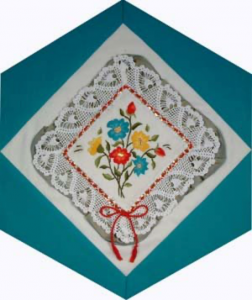Albania

The Block
Incorporating two national handcrafts, the idea for the Albania square came from blockmaker Mary Kerim’s childhood memory of having two sets of drapes in the home, one full-length crocheted, the other beige cotton with silk thread embroidery. Flowers, found both in the wild and in courtyard gardens, are a typical motif used in Albanian linens and are embroidered in bright colours.
The background is green satin, a fabric often used for the pants of women’s costumes. The entire piece was created, with the help of Ruth Lewis, to resemble a soft pillow and is reminiscent of the embroidered pillows traditionally used on the backs of chairs at the dinner table.
Traditionally, women embroider on linen or cotton, while men work on wool. Wool is widely available locally as large flocks of sheep are kept in Albania. Cotton, linen and silk are imported to supply embroiderers. Red cord and special gold broad plate, typically used in the embroidery of this region, is woven through the wide crocheted frame. Gold and silver thread are widely used as well. Embroidery is often produced in bands that are later attached to clothing or hats.
Cultural Profile
Albania, over 2000 years old and one of the smallest countries in Europe, is located on the Balkan Peninsula in the southeastern part of the continent. Primarily a farming country, with two main cultural groups, the Ghegs who live in the mountainous north, and the Tosks in the south. Each has its own dialect; however the official language is based on Tosk. Living in a less isolated region, the Tosks have been influenced by other cultures, such as the Greeks.
Several national handcrafts are practiced in Albania, including weaving, rich embroidery, crocheted lace and gold embroidery work. Many traditional homes have a loom used to weave wool, silk, cotton and linen into clothing, carpets, blankets, cushions and other household items.
The Albanian musical tradition of iso-polyphony is unique to the region and is listed as part of the Intangible Cultural Heritage by UNESCO. Performed mainly by men, it can be heard at weddings, funerals, harvest feasts, religious celebrations and festivals. The çifteli is a traditional string instrument comprising two strings. It is used in celebrations to accompany Albanian epics and ballads. Another traditional instrument, used by the Ghegs of the north, is the lahuta, a one-string instrument played with a bow.
Bujari (hospitality) is very important for Albania, over 2000 years old and one of the smallest countries in Europe, is located on the Balkan Peninsula in the southeastern part of the continent. Primarily a farming country, with two main cultural groups, the Ghegs who live in the mountainous north, and the Tosks in the south. Each has its own dialect; however the official language is based on Tosk. Living in a less isolated regions Albanians who warmly receive strangers and treat them as friends. In ancient times, anyone who disregarded the sacred principles of hospitality exposed themselves to severe punishment. Known also for their loyalty, there is a saying that ‘even war and death will not stop Albanians from keeping their word.’
Albanians proudly keep their heritage alive in Canada with the continued celebration of special occasions and traditions, both in the home and in the community organizations they have founded. The 2011 census listed more than 28,000 people of Albanian ancestry in Canada, up from 1,500 in 1986. They have settled mainly in southern Ontario, but also in Montreal and Alberta.
Sponsor: Albanian Muslim Women’s Association
